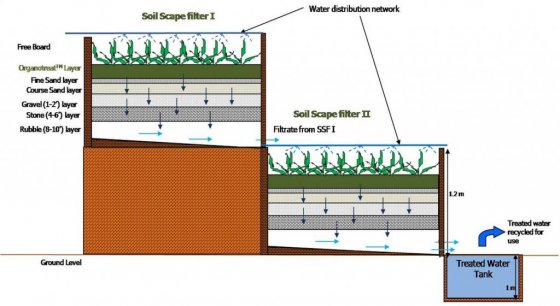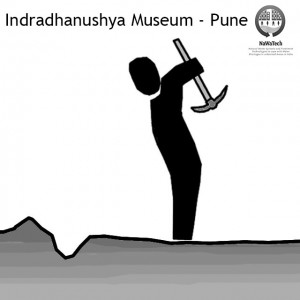Executive Summary
Alongside the Indradhanushya Environment Education and Citizenship Centre, a full-scale treatment system is installed to treat wastewater flowing through an adjacent open stream. Eco-filtration bank technology - consisting of screen, intake well, soil-scape filter beds as the main treatment unit, and a treated water pond - is being used to generate recycled water for garden irrigation and toilet flushing. This can tremendously reduce the pressure on fresh water demand while reducing the pollution of surface water bodies.
| The contents of this factsheet are results of the Indo-European Project NaWaTech- “Natural Water Systems and Treatment Technologies to cope with Water Shortages in Urbanised Areas in India”, co-financed by the EC and the DST – India. |
The main motivation for this project is to demonstrate that polluted water flowing through a stream and river can be treated and recycled for garden irrigation and flushing toilets in adjacent complexes. This will help to reduce the load on the fresh water supply in order to cope with water shortages in urbanised areas of India.
The project is implemented in the garden of the Indradhanushya Environment Education and Citizenship Centre (Rainbow Museum) located in Pune. This centre is a public facility of the Pune Municipal Corporation (PMC) to create awareness among the population about environment and sustainable development. The sewage contaminated Ambil stream encircles the elevated premises of the Indradhanushya building after flowing through the heart of Pune city.
Eco-filtration bank (EFB) technology was installed in the garden of the centre in order to treat wastewater and recycle it for non-consumptive purposes (construction finalised in December 2015). Overall, the EFB system is comprised of a screen, intake well, two soil-scape filter (SSF) beds as the main treatment unit, and a treated water pond, all aesthetically integrated into the existing garden facilities - particularly important as this site is a museum open to the general public. About 50 m3/day water from the stream will be diverted into the intake well and treated in the SSF beds to yield approx. 40 m3/day clean water for gardening and toilet flushing.
The SSF beds are the main treatment unit of this eco-technological treatment system involving the filtration of wastewater through biologically activated filtration media supported by sand and gravel (see figure). As the wastewater passes through the different media layers pollutants are absorbed and degraded. A combination of green plants and bacterial cultures are used to remove organic matter and pollutants. SSF harnesses the ecological processes of biodegradation, biotransformation and bioconversion at various trophic levels occurring in the detritus food chain by treating, transforming and detoxifying the pollutants using solar energy.

Cross section of soil scape filter units. Source: SERI (2014)
The characteristics and flow of the stream will vary daily/seasonally as per the use of water, nevertheless, expected percentage reductions regarding incoming pollutants after treatment lie in the range of 75-90% COD and BOD, 75-85% TSS, 99.9% faecal coliforms. The treated effluents (ca. 40 m3/day) are stored in a separated treated water tank and will mostly be used for gardening purposes, while any excess water will be used for flushing (currently, freshwater is being used for these purposes).
The entire system requires unskilled, but trained personnel for routine operation and maintenance works. The whole system can function by gravity, except small pumps for the initial loading of wastewater onto the filter bed from the intake well. There is no need of any chemicals for the process. Therefore, this system is an eco-friendly and cost-effective technique, requiring only little electricity, few routine maintenance works, and without the production of hazardous waste. It gives the opportunity to treat sewage located in rivers, storm-water drains, etc. (common scenario in many developing countries), reuse the water locally and, thus, reduce the pressure on fresh water demand.
Wastewater Treatment and Reuse in Indradhanushya Center, Pune, Maharashtra, India
Compendium of Natural Water Systems and Treatment Technologies to cope with Water Shortages in Urbanised Areas in India
The Compendium of NaWaTech Technologies presents appropriate water and wastewater technologies that could enable the sustainable water management in Indian cities. It is intended as a reference for water professionals in charge of planning, designing and implementing sustainable water systems in the Indian urban scenario, based on a decentralised approach.
BARRETO DILLON, L. ; DOYLE, L. ; LANGERGRABER, G. ; SATISH, S. ; POPHALI, G. (2013): Compendium of Natural Water Systems and Treatment Technologies to cope with Water Shortages in Urbanised Areas in India. Berlin: EPUBLI GMBH URL [Accessed: 11.12.2015]Ecotechnological Applications for the Control of Lake Pollution
This paper explains different ecotechnologies, such as soil scape filter, Hydrasch Succession Pond, Stream Ecosystem, Phytofiltration and Biox Process and Green Bridge Technology, which apply ecological principles, harnessing the living components of detritus food chain – bacteria, fungi, micro-invertebrates are found to be effective in the treatment of wastes.
JOSHI, S. ; JOSHI, S. (2008): Ecotechnological Applications for the Control of Lake Pollution. In: Proceedings of Taal2007: The 12th World Lake Conference: , 864-867.Physicochemical and biological processes of wastewater irrigation and land treatment
This paper describes the different physicochemical properties of soils, and their organic and inorganic constituents that allow for degradation of pollutants present in wastewater.
JOSHI, S. ; JOSHI, S. ; KUBER, B. (2002): Physicochemical and biological processes of wastewater irrigation and land treatment. First Workshop on Reuse of Treated Wastewater and Sludge for Agriculture in South Asia. In: Proceedings of International Work Plan of GWP – SASTAC on Reuse of City Effluents :ILBM Impact Story - Ecological Restoration of Highly Polluted Stretch of Ahar River, Udaipur and Ecological Improvement of Udaisagar Lake, Rajasthan, India
Ecological restoration of Ahar River in Udaipur and the subsequent improvement of Udaisagar Lake have together become a landmark in the application of ILBM principles to successfully convert an aerobically dead river into a living lotic system. This was initiated in the ILBM meeting organized in August 2009 and then within 63 days the ecotechnological Green Bridge system was developed after getting four of the pillars – policy, institutions, finance and public participation to support knowledge and technology pillars to revitalize a terminal lake – Udaisagar Lake by treating the wastewaters flowing through the Ahar River.
KODARKAR, M. JOSHI, S. (n.y): ILBM Impact Story - Ecological Restoration of Highly Polluted Stretch of Ahar River, Udaipur and Ecological Improvement of Udaisagar Lake, Rajasthan, India. URL [Accessed: 19.03.2015]http://www.nawatech.net/
This is the official webpage of the NaWaTech Collaborative Project, containing all key information related to the different case studies, activities and results of the project.


